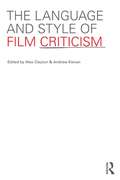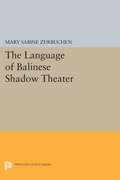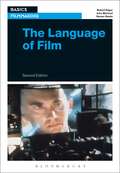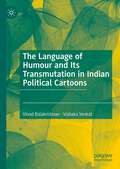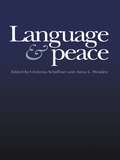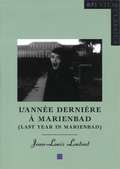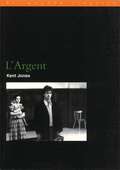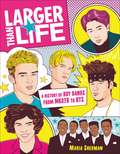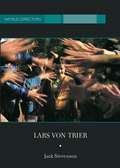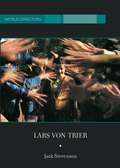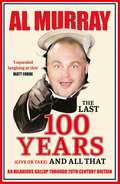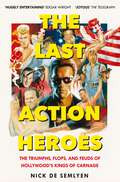- Table View
- List View
The Language and Style of Film Criticism
by Alex Clayton Andrew KlevanThe Language and Style of Film Criticism brings together original essays from an international range of academics and film critics highlighting the achievements, complexities and potential of film criticism. In recent years, in contrast to the theoretical, historical and cultural study of film, film criticism has been relatively marginalised, especially within the academy. This book highlights the distinctiveness of film criticism and addresses ways in which it can take a more central place within the academy and develop in dynamic ways outside it. The Language and Style of Film Criticism is essential reading for academics, teachers, students and journalists who wish to understand and appreciate the language and style of film criticism.
The Language and Style of Film Criticism
by Andrew Klevan Alex ClaytonThe Language and Style of Film Criticism brings together original essays from an international range of academics and film critics highlighting the achievements, complexities and potential of film criticism. In recent years, in contrast to the theoretical, historical and cultural study of film, film criticism has been relatively marginalised, especially within the academy. This book highlights the distinctiveness of film criticism and addresses ways in which it can take a more central place within the academy and develop in dynamic ways outside it. The Language and Style of Film Criticism is essential reading for academics, teachers, students and journalists who wish to understand and appreciate the language and style of film criticism.
Language, Music, and Computing: First International Workshop, LMAC 2015, St. Petersburg, Russia, April 20-22, 2015, Revised Selected Papers (Communications in Computer and Information Science #561)
by Polina Eismont Natalia KonstantinovaThis book constitutes the proceedings of the First International Workshop on Language, Music and Computing, LMAC 2015, held in St. Petersburg, Russia, in April 2015. The 13 papers presented in this volume were carefully reviewed and selected from 38 submissions. They were organized in topical sections on music and language in education; corpus studies of language and music; problems of notation; and linguistic studies of music.
The Language of Balinese Shadow Theater
by Mary Sabine ZurbuchenBali's shadow puppet theater, like others in Southeast Asia, is a complex tradition with many conventions that puzzle Western observers. Mary Zurbuchen demonstrates how the linguistic codes of this rich art form mediate between social groups, cultural influences, historical periods, and conceptual schemes.Originally published in 1987.The Princeton Legacy Library uses the latest print-on-demand technology to again make available previously out-of-print books from the distinguished backlist of Princeton University Press. These editions preserve the original texts of these important books while presenting them in durable paperback and hardcover editions. The goal of the Princeton Legacy Library is to vastly increase access to the rich scholarly heritage found in the thousands of books published by Princeton University Press since its founding in 1905.
The Language of Defamation Cases
by Roger W. ShuySlander and libel cases are largely about how one party uses language in ways that are claimed to defame one another. Linguistic expertise can be central to the case. In The Language of Defamation Cases, Roger W. Shuy describes eleven representative lawsuits--involving newspapers, television stations, religious leaders, physicians, teachers, entertainers, unions, insurance companies, and manufacturers--for which he served as a consultant. Shuy's linguistic analysis illustrates how grammatical referencing, speech acts, discourse structure, framing, conveyed meaning, intentionality, and malicious language affected the outcome of these cases. The Language of Defamation Cases shows how linguistics can be used to help resolve libel and slander cases. It will appeal to students and scholars of applied linguistics and forensic linguistics.
The Language of Defamation Cases
by Roger W. ShuySlander and libel cases are largely about how one party uses language in ways that are claimed to defame one another. Linguistic expertise can be central to the case. In The Language of Defamation Cases, Roger W. Shuy describes eleven representative lawsuits--involving newspapers, television stations, religious leaders, physicians, teachers, entertainers, unions, insurance companies, and manufacturers--for which he served as a consultant. Shuy's linguistic analysis illustrates how grammatical referencing, speech acts, discourse structure, framing, conveyed meaning, intentionality, and malicious language affected the outcome of these cases. The Language of Defamation Cases shows how linguistics can be used to help resolve libel and slander cases. It will appeal to students and scholars of applied linguistics and forensic linguistics.
The Language of Dystopia (Palgrave Studies in Language, Literature and Style)
by Jessica NorledgeThis book presents an extended account of the language of dystopia, exploring the creativity and style of dystopian narratives and mapping the development of the genre from its early origins through to contemporary practice. Drawing upon stylistic, cognitive-poetic and narratological approaches, the work proposes a stylistic profile of dystopia, arguing for a reader-led discussion of genre that takes into account reader subjectivity and personal conceptualisations of prototypicality. In examining and identifying those aspects of language that characterise dystopian narratives and the experience of reading dystopian fictions, the work discusses in particular the manipulation and construction of dystopian languages, the conceptualisation of dystopian worlds, the reading of dystopian minds, the projection of dystopian ethics, the unreliability of dystopian refraction, and the evolution and hybridity of the dystopian genre.
The Language of Film (Basics Filmmaking)
by Robert Edgar John Marland Steven RawleAn effective filmmaker needs to have a good understanding of how film language works, and more importantly, how to actively influence an audience's thoughts and feelings and guide their gaze around the screen.Packed with examples from classic and contemporary cinema, The Language of Film reveals the essential building blocks of film and explains how the screen communicates meaning to its audience. You will learn about fundamental theories and concepts, including film semiotics, narrative structures, ideology, and genre, as well as how elements such as shot size, camera movement, editing technique, and color come together to create the cinematic image.With insightful case studies and discussion questions, dozens of practical tips and exercises, and a new chapter on film sound, this new edition of The Language of Film is a must-have guide for aspiring filmmakers.
The Language of Film (Basics Filmmaking Ser.)
by Robert Edgar John Marland Steven RawleAn effective filmmaker needs to have a good understanding of how film language works, and more importantly, how to actively influence an audience's thoughts and feelings and guide their gaze around the screen.Packed with examples from classic and contemporary cinema, The Language of Film reveals the essential building blocks of film and explains how the screen communicates meaning to its audience. You will learn about fundamental theories and concepts, including film semiotics, narrative structures, ideology, and genre, as well as how elements such as shot size, camera movement, editing technique, and color come together to create the cinematic image.With insightful case studies and discussion questions, dozens of practical tips and exercises, and a new chapter on film sound, this new edition of The Language of Film is a must-have guide for aspiring filmmakers.
The Language of Humour and Its Transmutation in Indian Political Cartoons
by Vinod Balakrishnan Vishaka VenkatThis book develops a model to examine the language of humour, which is multimodal and accounts for the possibility of transmutation of humour as it is performed through editorial cartoons. By transmutation is meant the transition in the language of humour when it crosses its own boundaries to provoke unprecedented reactions resulting in offensiveness, disappointment or hurt sentiment. The transmutability about the language of humour points to its inherently diabolical nature which manifests in the performance of controversial cartoons. The model is built by borrowing theoretical cues from Roman Jakobson, Roland Barthes, George Lakoff and Mark Johnson. The integrated model, then, is developed to examine the cartoons which were recommended for deletion by the Thorat Committee, following a cartoon controversy in India. Through the cartoon analysis, the model discerns the significance of context and temporality in determining the impact of humour. It also examines how the ethics of humour; the blurred lines of political correctness and incorrectness are dictated by the political atmosphere and the power dynamics.
Language & Peace (War And Peace Ser. #Vol. 6)
by Christina Schäffne Anita L. WendenFirst published in 1999. Routledge is an imprint of Taylor & Francis, an informa company.
Language & Peace
by Christina Schäffne Anita L. WendenFirst published in 1999. Routledge is an imprint of Taylor & Francis, an informa company.
Languid Bodies, Grounded Stances: The Curving Pathway of Neoclassical Odissi Dance (Dance and Performance Studies #9)
by Nandini SikandWidely believed to be the oldest Indian dance tradition, odissi has transformed over the centuries from a sacred temple ritual to a transnational genre performed—and consumed—throughout the world. Building on ethnographic research in multiple locations, this book charts the evolution of odissi dance and reveals the richness, rigor, and complexity of the form as it is practiced today. As author and dancer-choreographer Nandini Sikand shows, the story of odissi is ultimately a story of postcolonial India, one in which identity, nationalism, tradition, and neoliberal politics dramatically come together.
L'Année dernière à Marienbad (BFI Film Classics)
by Jean-Louis LeutratA quintessential work of 1960s European art cinema, L'Année dernière à Marienbad (Last Year in Marienbad, 1961) was a collaboration between director Alain Resnais and 'New Novel' enfant terrible Alain Robbe-Grillet. Three people, known only by their initials, move through the sprawling luxury of a mysterious hotel and its ornamental gardens. Perhaps M is A's husband and X her lover. Perhaps, 'last year', A promised X she would leave with him. Or is there something more terrible in the past? An abstract thriller, a love story, a philosophical puzzle, 'the film's deviations are', for Jean-Louis Leutrat, 'as complex as those of the human heart'.
L'Année dernière à Marienbad (BFI Film Classics)
by Jean-Louis LeutratA quintessential work of 1960s European art cinema, L'Année dernière à Marienbad (Last Year in Marienbad, 1961) was a collaboration between director Alain Resnais and 'New Novel' enfant terrible Alain Robbe-Grillet. Three people, known only by their initials, move through the sprawling luxury of a mysterious hotel and its ornamental gardens. Perhaps M is A's husband and X her lover. Perhaps, 'last year', A promised X she would leave with him. Or is there something more terrible in the past? An abstract thriller, a love story, a philosophical puzzle, 'the film's deviations are', for Jean-Louis Leutrat, 'as complex as those of the human heart'.
L'Argent (BFI Film Classics)
by Kent JonesThe career of Robert Bresson (b. 1907) is one of the richest in the history of cinema, but also one of the most enigmatic. For some commentators, Bresson is a severe moralist who's almost medieval in his concern for the darker aspects of Catholic theology. For others, he's best seen as a stylist whose work has consistently anticipated cinematic trends. Just as Bresson's 1959 'Pickpocket 'was remodelled by Paul Schrader as 'American Gigolo '(1980), so 'L'Argent '(1983) is a study of spontaneous murder and a meditation on evil that has a striking kinship with contemporary vigilante and serial killer films. Kent Jones disputes some of the received wisdom about Bresson's work as it's epitomized by 'L'Argent': the work can't simply be reduced to its austere, pessimistic, or religious elements. By exploring the many dimensions of' L'Argent,' Jones finds other elements: beauty, compassion, an overriding concern with the meaningful depiction of experience. 'L'Argent 'is the culminating work of one of the select group of directors able 'to push the cinema, through the force of their own genius, onto a new plain.'
L'Argent (BFI Film Classics)
by Kent JonesThe career of Robert Bresson (b. 1907) is one of the richest in the history of cinema, but also one of the most enigmatic. For some commentators, Bresson is a severe moralist who's almost medieval in his concern for the darker aspects of Catholic theology. For others, he's best seen as a stylist whose work has consistently anticipated cinematic trends. Just as Bresson's 1959 'Pickpocket 'was remodelled by Paul Schrader as 'American Gigolo '(1980), so 'L'Argent '(1983) is a study of spontaneous murder and a meditation on evil that has a striking kinship with contemporary vigilante and serial killer films. Kent Jones disputes some of the received wisdom about Bresson's work as it's epitomized by 'L'Argent': the work can't simply be reduced to its austere, pessimistic, or religious elements. By exploring the many dimensions of' L'Argent,' Jones finds other elements: beauty, compassion, an overriding concern with the meaningful depiction of experience. 'L'Argent 'is the culminating work of one of the select group of directors able 'to push the cinema, through the force of their own genius, onto a new plain.'
Larger Than Life: A History of Boy Bands from NKOTB to BTS
by Maria Shermanp.p1 {margin: 0.0px 0.0px 0.0px 0.0px; font: 14.0px Calibri} p.p2 {margin: 0.0px 0.0px 0.0px 0.0px; font: 14.0px Calibri; min-height: 17.0px} This nostalgic, fully-illustrated history of boy bands -- written by culture critic and boy band stan Maria Sherman -- is a must-have for diehard fans of the genre and beyond.The music, the fans, the choreography, the clothes, the merch, the hair. Long after Beatlemania came and went, a new unstoppable boy band era emerged. Fueled by good looks and even greater hooks, the pop phenomenon that dominated the '80s, '90s, and 2000s has left a long-lasting mark on culture, and it's time we celebrate it. Written by super fan Maria Sherman for stans and curious parties alike, Larger Than Life is the definitive guide to boy bands, delivered with a mix of serious obsession and tongue-in-cheek humor.Larger Than Life begins with a brief history of male vocal groups, spotlighting The Beatles, the Jackson 5, and Menudo before diving into the building blocks of these beloved acts in "Boy Bands 101." She also focuses on artists like New Edition, New Kids on the Block, Backstreet Boys, *NSYNC, One Direction, and BTS before ending with an interrogation into the future of boy bands. Included throughout are Tiger Beat-inspired illustrations, capsule histories of the swoon-iest groups, in-depth investigations into one-hit wonders, and sidebars dedicated to conspiracy theories, dating, in-fighting, haters, fan fiction, fashion (Justin and Britney in denim, of course), and so much more.Informative, affectionate, funny, and never, ever fan-shaming, Larger Than Life is the first and only text of its kind: the ultimate celebration of boy bands and proof that this once maligned music can never go unappreciated.
Lars Von Trier: Lars Von Trier, Thomas Vinterberg, And The Gang That Took On Hollywood (World Directors)
by Jack StevensonWith the international success of Breaking the Waves (1996) and Dancer in the Dark (2000), Lars von Trier has established himself as a one of the most provocative and daring film directors working today. The founding father of Dogma 95, he made the movement's most controversial film, The Idiots (1998), and has played a leading role in the recent resurgence of Danish cinema. Yet despite his success, von Trier remains something of an polarising and enigmatic figure hailed as the new Godard by some and a charlatan by others. In this new study, Jack Stevenson explores the achievements as well as the paradoxes of Lars von Trier, assessing his life, work, and critical reception. The book follows von Trier from his early life as a troubled son of 'Cultural Radical' parents through to his student days at the Danish Film School, diligently spent making films that were as innovative and disturbing as his later features have proved to be. These films (consisting of the Europa and Gold-Hearted trilogies) are fully examined together with considerations of his creative detours into other media and his current work in progress, Dogville. Based in Denmark, the author brings a unique perspective to Lars von Trier creating a multi-dimensional portrait of the director. Utilising sources heretofore unavailable in English, Stevenson's lively yet fact-filled narrative is accessible to students and film enthusiasts alike. The book is indispensable to anyone interested in Lars von Trier and the broader issues that surround modern Danish film and its current renaissance.
Lars Von Trier (World Directors)
by Jack StevensonWith the international success of Breaking the Waves (1996) and Dancer in the Dark (2000), Lars von Trier has established himself as a one of the most provocative and daring film directors working today. The founding father of Dogma 95, he made the movement's most controversial film, The Idiots (1998), and has played a leading role in the recent resurgence of Danish cinema. Yet despite his success, von Trier remains something of an polarising and enigmatic figure hailed as the new Godard by some and a charlatan by others. In this new study, Jack Stevenson explores the achievements as well as the paradoxes of Lars von Trier, assessing his life, work, and critical reception. The book follows von Trier from his early life as a troubled son of 'Cultural Radical' parents through to his student days at the Danish Film School, diligently spent making films that were as innovative and disturbing as his later features have proved to be. These films (consisting of the Europa and Gold-Hearted trilogies) are fully examined together with considerations of his creative detours into other media and his current work in progress, Dogville. Based in Denmark, the author brings a unique perspective to Lars von Trier creating a multi-dimensional portrait of the director. Utilising sources heretofore unavailable in English, Stevenson's lively yet fact-filled narrative is accessible to students and film enthusiasts alike. The book is indispensable to anyone interested in Lars von Trier and the broader issues that surround modern Danish film and its current renaissance.
Lars von Trier's Women
by David Denny Rex ButlerThe Danish director Lars von Trier is undoubtedly one of the world's most important and controversial filmmakers, and arguably so because of the depiction of women in his films. He has been criticized for subjecting his female characters to unacceptable levels of violence or reducing them to masochistic self-abnegation, as with Bess in Breaking the Waves, 'She' in Antichrist and Joe in Nymphomaniac. At other times, it is the women in his films who are dominant or break out in violence, as in his adaptation of Euripides' Medea, the conclusion of Dogville and perhaps throughout Nymphomaniac. Lars von Trier's Women confronts these dichotomies head on. Editors Rex Butler and David Denny do not take a position either for or against von Trier, but rather consider how both attitudes fall short of the real difficulty of his films, which may simply not conform to any kind of feminist or indeed anti-feminist politics as they are currently configured. Using Lacanian psychoanalysis and acknowledging the work of prior scholars on the films, Lars von Trier's Women reveals hidden resources for a renewed 'feminist' politics and social practice.
Lars von Trier's Women
by David Denny Rex ButlerThe Danish director Lars von Trier is undoubtedly one of the world's most important and controversial filmmakers, and arguably so because of the depiction of women in his films. He has been criticized for subjecting his female characters to unacceptable levels of violence or reducing them to masochistic self-abnegation, as with Bess in Breaking the Waves, 'She' in Antichrist and Joe in Nymphomaniac. At other times, it is the women in his films who are dominant or break out in violence, as in his adaptation of Euripides' Medea, the conclusion of Dogville and perhaps throughout Nymphomaniac. Lars von Trier's Women confronts these dichotomies head on. Editors Rex Butler and David Denny do not take a position either for or against von Trier, but rather consider how both attitudes fall short of the real difficulty of his films, which may simply not conform to any kind of feminist or indeed anti-feminist politics as they are currently configured. Using Lacanian psychoanalysis and acknowledging the work of prior scholars on the films, Lars von Trier's Women reveals hidden resources for a renewed 'feminist' politics and social practice.
The Last 100 Years (give or take) and All That: A hilarious gallop through 20th-century history
by Al MurrayA fascinating and hilarious gallop through twentieth-century British history, by comedian Al Murray.An awful lot has happened in the last 100 years or so. In fact, when you look at how much went on in the 20th century, it's amazing it didn't take longer than that. And what have we learnt? A few obvious lessons include: megalomaniac men with moustaches in charge of countries tend to turn out to be BAD; anyone who thinks they can explain let alone sort out the Middle East is WRONG; France simply cannot be relied upon; America may or may not be the cause of everything GOOD and BAD in the world (depending on who you ask).This isn't your bog-standard history book. We all know that history books (Which Shall Not be Questioned because they ARE ALL TRUE according to our History Teachers of Yore) are dry and dull, and they go on as if there's only ONE version of history (spoiler: it's all about perspective). Enter Al Murray, alter-ego of everyone's favourite Pub Landlord.Al knows his way around 20th century Britain, and he's good enough to illuminate it for you. From the Big Bang of the 20th Century, DOUBLEYOUDOUBLEYOU ONE, to the eve of the new Millennium (when all the computers in the World DIDN'T stop working and the Queen had to do the Hokey Cokey with Tony Blair) and all the forgotten tales in between, this is a brilliantly funny, irreverent and eye-opening whistle-stop tour of Britain since 1914.
The Last Action Heroes: The Triumphs, Flops, and Feuds of Hollywood's Kings of Carnage
by Nick de Semlyen'A blast' - Ian Rankin'A lively celebration of 1980s action stars' - The Times'Hugely entertaining' - Edgar WrightNow with BONUS MATERIAL, from the editor of Empire magazine this is the behind-the-scenes story of the golden age of the action movie, the stars who ruled 80s and 90s Hollywood and the beloved films – from Die Hard to The Terminator – that made them famous.Charting Sylvester Stallone and Arnold Schwarzenegger’s carnage-packed journey from enmity to friendship against the backdrop of Reagan’s America and the Cold War. It also reveals the untold stories of the colourful characters, from Steven Seagal to Bruce Willis, who ascended in their wake. These invincible action heroes used muscle, martial arts or the perfect weapon to save the day, becoming pop-culture titans.Drawing on candid interviews with the action stars themselves, plus their collaborators, friends and foes, Nick de Semlyen' s The Last Action Heroes chronicles how, as the 1990s rolled in, the glory days of these macho men began to fade, but how the mayhem they wrought on screen and off excites us still.
Last Call at the Oasis: The Global Water Crisis and Where We Go from Here
by Participant Media&“If there was a price placed on clean water we might start treating it like it has value. Maybe when it&’s gone we'll realize we can&’t drink oil or money.&” —Dave Matthews Less than 1 percent of the world&’s water is fresh and potable—and no more will ever be available. Thanks to pollution, global warming, and population growth, water access is poised to become today&’s most explosive global issue. This book, based on the film Last Call at the Oasis by Academy Award®–winning director Jessica Yu, offers insights into the coming water crisis from visionary scientists, policymakers, activists, and environmentalists, including: ROBERT MORAN on how oil and mineral development pollute and divert water supplies—often beyond public scrutinyPETER H. GLEICK on discovering the &“soft path&” to global water securityROBERT GLENNON on how the power of markets can help protect the world&’s waterLYNN HENNING on how a family farmer became a passionate &“water activist&”ALEX PRUD&’HOMME on how the water crisis affects us allGARY WHITE on how innovative social and economic strategies can make clean water available even for the world&’s poorest peopleHADLEY ARNOLD AND PETER ARNOLD on how arid regions like America&’s Southwest can wisely husband water supplies for cities and farmers alikeROBYN BEAVERS on how today&’s smartest businesses are making sustainable water management a competitive advantageZEM JOAQUIN on nine &“ecofabulous&” ways of saving water at home—and doing it with styleBILL MCDONOUGH on how smart design can preserve water&’s &“Endless Resourcefulness&” for generations to come No resource on earth is more precious—or more endangered—than water. Last Call at the Oasis is a powerful tool for learning about the water challenges we face as well as the remarkable solutions available to us—if we have the will to use them.
